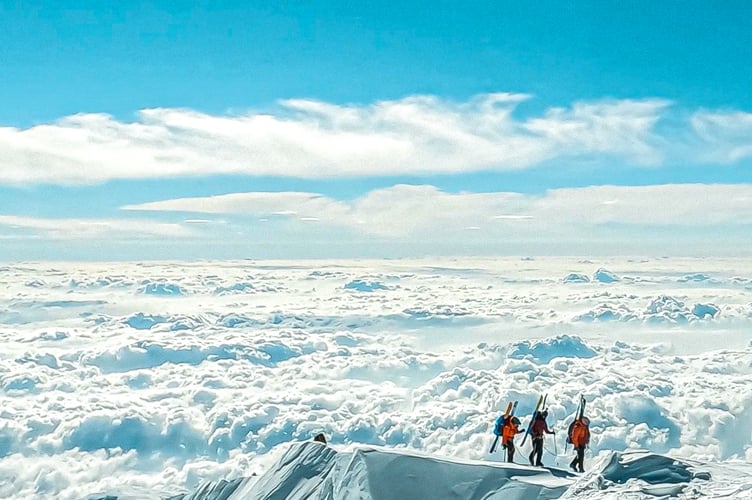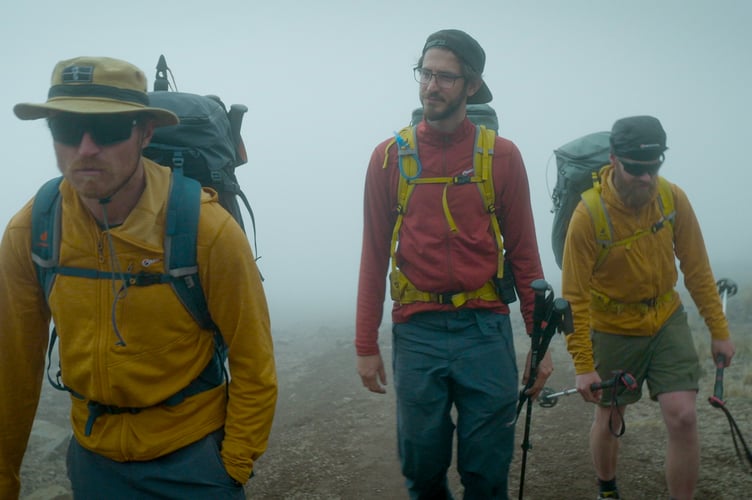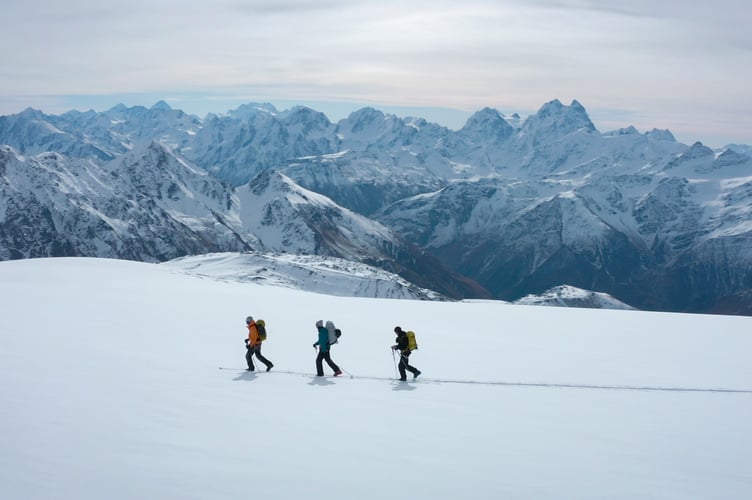Kids are often told that it’s not the winning but the taking part that counts.
But let’s be honest: coming first in a challenge, race or competition does feel nice, especially if it’s never been done before.
Edward Salisbury has felt the ‘top of the world’ sensation many times before. The Churt carpenter is an exceptional skier and climber who has conquered some of the world’s highest mountains.
His name is likely to go down in history as he’s midway through a bid to climb up – then ski down – the highest mountain on every continent.
But the problem is, Edward is certain that he and his two climbing partners will also be last to achieve the feat, and what turned into an adrenaline-fuelled adventure has turned the trio into “accidental activists”.
“I’ve always had this desire to ski and strange and different places, to ski in every continent,” said Edward about the beginnings of The Last Ride Project.

“I pitched the idea to my climbing partner, Will, and he got on board so we started looking into it and there was a huge amount of research.
“We looked up routes, weather patterns, changing condition, climbing times, times of year. But when we started looking at aerial pictures, from 2000 and 2008, that’s when things really started to hit us.
“It was at that point we realised would not only be the first people to do this, but also the last.”
Edward, Will Tucker and award-winning filmmaker Jon Moy are now on a mission to showcase how climate change is affecting some of the world’s mightiest mountains and their surroundings, from the glaciers and ice sheets to the people living in their shadow.

The focus has developed from achieving an adventurous world-first to a much larger picture. It’s a spin on a documentary about climate change, using sport, adventure and action to attract an audience that otherwise might turn away.
Some mountains have already been ticked off the list. Elbrus in the Russian Caucasus was one of the early peaks while the trio absolutely loved their experiences in Alaska conquering Denali, North America’s highest mountain.
Things also got “quite intense” on a glacier on the Andean peak of Aconcagua but the real “jaw-dropping” moment was their expedition up Kilimanjaro. Its snow-capped peak is looking less white these days and could become a thing of the past within the next decade.
“We were looking at all these routes but they no longer existed,” said Mr Salisbury in recalling how the trio could ski down a mountain with next to no snow.
“Eighty per cent of ice mass has been lost since 2006. At the top of the mountain it was plus 12 degrees.
“It’s such a bizarre feeling to be in a ski suit but climbing and walking on sand searching for a piece of ice, but what’s happening is affecting the whole weather system around it and what people depend on.”

He added: “The amount of ice lost in the Himalayas and Alaska is mind-blowing. The project was needed because there’s a much bigger story to be told.”
The Last Ride Project has been labelled “an ambitious world first in global ski mountaineering” and an exploratory documentary that “investigates catastrophic deglaciation and its effects on the border climate emergency.”
It's got some big backers, too, as the series is being produced by Louis Theroux‘s Mind House, with executive producer Gillian Anderson. The pictures are incredible while the trailer will genuinely give people goosebumps.
Edward has been skiing since he was a young teenager and was part of Team GB for a while. The joy of skiing on virgin snow and the lure of going that little bit further was a key factor in the gestation of The Last Ride.
He said: “Nothing beats skiing in the middle of nowhere.
“You can have a beautiful connection between you and a mountain and I think a lot of the population has become disconnected from that feeling and that link.
He added: “You can be walking up a glacier among huge ice formations towering above you and then realise what a small cog in the world you are. It has an amazing effect and it’s a phenomenal juxtaposition.”
Edward, who is from Windsor but has spent much of life in the Farnham area, realises that some people will see the project as hypocritical. Not everyone can spend thousands of pounds travelling around the world to climb and ski down distant mountains, and that’s before the carbon footprint of such an enormous project is mentioned.
Mr Salisbury can see the point, but he has argued that the message about the world’s impact on these landscapes – especially some of the wilder and more remote ones – may remain a terrible secret without their often dangerous travels. There are risks with every ascent, from a fatal fall to oxygen deprivation.
“The Last Ride Project has opened this lid of hypocrisy and I’ve thought about it,” admitted Edward.
“We’re three guys who live in the western world and we’re exploring glaciers. How is that going to save things? Are we part of the problem?
“But we’re responsible for the industrial revolution and we’re part of the global north, so we’re part of the system that has created this. Now we’ve got to do as much as we can to solve the problem.”
He added: “What we’re doing is getting people excited in a very serious issue through sport, adventure and nature.”
The trio will next travel to Indonesia to conquer Puncak Jaya before setting their sights on the big one – Everest – and the Antarctic peak of Mount Vinson.

The former will involve an epic 7,000 feet of skiing while the journey to the latter is gargantuan, involving a trip to the southern end of Chile before crossing The Drake Passage and a 12-day expedition across one of the coldest, iciest and most remote areas on earth. And that’s before they arrive at base camp and climb the 2,000 metre-plus mountain before their historic descent on skis.
“I know climbing Everest is controversial these days and a few who don’t necessarily have the experience or ability shouldn’t really be there,” said Edward in recalling the infamous picture of climbers queuing up to reach its 8,849-metre summit.
“But the media got hold of this image and twisted it.
Thing is, you have a finite climbing season in the Himalayas. People think it’s like that all the time but if you’ve granted 380 permits and you’ve got a two-day window then it’s going to be like that.”
And there’s no getting round the fact the trio will be in that position soon as they look to complete a genuine world-first. Only time will tell if their project does change the world, but even if only brings a very serious issue to more people’s attention, then a mission will have succeeded.
Edward added: “A lot of this is getting people aware of what’s happening and what they can do.
“It’s time to rekindle and reconnect between humans and nature. We’re not against nature, we’re part of that connection, and we just have to be part of the solution.”
For more visit www.thelastrideproject.com




